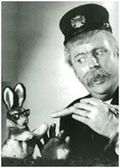 A lot of us can probably remember Captain Kangaroo, which was one of the longest running network children’s shows of all time, airing continuously on CBS from 1955 until 1984 and then in re-runs on PBS from 1986 to 1993. The show starred Bob Keeshan as the Captain, named for the huge pouch-like pockets on his jacket. Keeshan had previously played the clown Clarabell on the Howdy Doody Show.
A lot of us can probably remember Captain Kangaroo, which was one of the longest running network children’s shows of all time, airing continuously on CBS from 1955 until 1984 and then in re-runs on PBS from 1986 to 1993. The show starred Bob Keeshan as the Captain, named for the huge pouch-like pockets on his jacket. Keeshan had previously played the clown Clarabell on the Howdy Doody Show.
The show took place in the Captain’s Treasure House, where the Captain read stories, met guests, showed cartoons, and interacted with a regular cast of both humans and puppets, including the Captain’s sidekick Mr. Green Jeans, and puppet characters Mr. Moose and Bunny Rabbit. Bunny Rabbit usually tricked the Captain into giving him carrots. Mr. Moose would pepper the Captain with riddles and knock-knock jokes, which always culminated with hundreds of ping-pong balls raining down on the Captain’s head.
Other regular characters included Mr. Baxter, who exuded a sense of calm when things got a little too silly, and Slim Goodbody, a character who wore a bodystocking painted with the body’s internal organs on it. And there was also the Banana Man, a clown who would constantly pull a seemingly endless supply of bananas (and also watermelons) from within his coat. The Banana Man didn’t speak but he hummed continuously in a high-pitched falsetto as he performed, and would occasionally exclaim “Wow!” in the same falsetto voice.
Among the well-known personalities who appeared on the show over the years were Bill Cosby, who did educational segments, and puppeteer/performer Kevin Clash, who later became the puppeteer and voice of Elmo on Sesame Street.
There were several cartoon segments that were shown regularly. Probably the best-known was Tom Terrific, which aired on the show in the 1950’s and 1960’s. Tom Terrific consisted of 3-5 minute segments drawn in simple stick-figure-like black-and-white animation. Tom was a little boy who could change into any shape he wanted, usually to save his not-too-bright sidekick, Mighty Manfred the Wonder Dog, from the villain Crabby Appleton and other bad guys.
Other cartoon segments included Lariat Sam, Simon in the Land of Chalk Drawings, Ludwig, The Most Important Person, The Toothbrush Family, Crystal Tipps, and The Wombles.
The show often featured simple black light theater segments with cardboard cutouts that cavorted on the screen while a recording of a popular song, like Over the Rainbow, would play. Sometimes, hand puppets would perform instead of the cardboard cutouts.
Keeshan conceived of Captain Kangaroo as a warm, grandfatherly character, and the show had a gentle feeling and gentle pace. It was a full 60-minutes long for most of the years that it aired, which allowed it to include a rich and diverse range of segments and characters without seeming frenetic or too busy. As portrayed by Keeshan, the Captain became a beloved and iconic figure who still represents the best of what television can offer its youngest viewers.
Keeshan wrote about his life as Captain Kangaroo in Good Morning Captain: 50 Wonderful Years with Bob Keeshan, TV’s Captain Kangaroo and Growing Up Happy: Captain Kangaroo Tells Yesterday’s Children How to Nuture Their Own .

Recent Comments